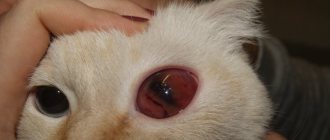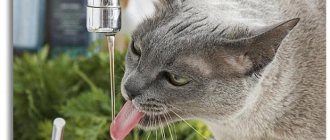A cat's health can be judged with confidence by its appearance. The organs of vision are the first to react to its deterioration. The eyes of a healthy cat are bright, clean, without traces of discharge in the corners. And if their condition is far from ideal, we can assume that the animal is sick.
Red eye syndrome in cats is a very common symptom. It often indicates ophthalmological problems, and sometimes indicates a somatic disease. Reddened protein in most cases is accompanied by itching, burning, lacrimation, photophobia, hemorrhages in the iris, and blepharospasm. Red, inflamed eyes indicate that blood circulation in their choroid is impaired, the blood vessels are dilated, and the surrounding tissues are inflamed. From this article you will learn what causes eye redness and what to do to help your cat.
Why are my eyes red?
If the owner notices that his pet’s eyes have become red, the possibility of developing some disease cannot be ruled out. Why does the cat have red eyes? This is what we will find out now.
Redness can occur for the following reasons:
- structural changes in the eye and accompanying diseases;
- viral or bacterial diseases;
- allergic reactions;
- eye injuries.
Only a veterinarian can make an accurate diagnosis. There is no point in postponing a visit to him. We will tell you about the most common and dangerous diseases, signs of which are red eyes in cats.
First aid and prevention
Why do my cats always have red eyes? The reason is different in each specific case. The syndrome may be a consequence of violation of the rules for caring for the animal, or it may be a symptom of a serious illness. Therefore, if the redness does not go away for a long time, you should not delay a visit to the veterinarian. Only he can make a high-quality diagnosis, assess the pet’s condition and determine further treatment tactics.
If the owner does not have the opportunity to immediately go to the clinic, you can use first aid techniques for ophthalmological problems. They will help alleviate the pet’s condition somewhat and, in some cases, have a therapeutic effect.
- It is necessary to put a protective collar on the neck of a cat or kitten, which will prevent them from touching their eyes with their paws, and therefore prevent the risk of secondary infection.
- You should regularly remove discharge from the eyes and rinse them with cotton pads soaked in warm boiled water or a strong solution of tea leaves.
- To reduce the inflammatory reaction, you can instill antiseptic eye drops or an “artificial tear” drug.
- Hair hanging over the eyes should be trimmed more often so that it does not injure the cornea.
If you ignore a symptom such as redness of the eye sclera, you may miss the onset of a serious illness in your cat. It’s better to play it safe and take your pet to the veterinarian as soon as possible for an examination and consultation, so that you don’t have to regret the lost time later.
Inflammation of the eyelids
The disease is caused by fungal and bacterial infections. The main signs of inflammation of the eyelids or blepharitis:
- The eyelids are swollen and inflamed.
- Over time, baldness of the eyelids begins to occur.
- Your pet rubs his eyes all the time and is bothered by itching.
- The eyes are “crying.” The discharge is purulent or mucous. The cat has a red eye or both. Most often, both eyes turn red.
- Strabismus may occur.
- The pet blinks frequently.
How to help your pet? Do not hesitate to visit a veterinarian. It is possible that surgery will be required. It is carried out in severe cases of the disease. The rest prescribe antibiotics, ointments, and antifungal drugs.
Causes of blepharitis
The causes of blepharitis may be:
- decreased immunity due to bacterial, viral and parasitic infections;
- mechanical, chemical and thermal eye injuries;
- constant mechanical irritation of the eyelids due to the presence of ticks, fleas and other ectoparasites in the animal’s fur;
- lack of eye and eyelid hygiene;
- poor maintenance of the animal: poor quality food, dust and dirt in the room;
- vitamin deficiency, anemia, exhaustion of the animal;
- allergic reaction to care products (shampoo, soap, hair brush);
- kidney disease;
- skin fungal diseases;
- disruption of the sebaceous glands, in which seborrhea develops, affecting the eyelids of the animal;
- helminthic infestations.
Conjunctivitis
This is an inflammation of the protective membrane of the eye (conjunctiva). If your cat's eye is red and pus-filled, sticky and watery, he could have contracted conjunctivitis.
There are two types of disease: caused by a bacterial infection and viral. In the first case, the disease develops very quickly, in the second - quite slowly.
It is important to consider that the eyes do not always fester with conjunctivitis. The cat's eye is red. Or both eyes. A colorless mucous liquid flows out of them. And these secretions “slow down” the rapid recognition of the disease. This is a viral form of the disease.
If the pet has contracted bacterial conjunctivitis, then there may be no redness of the eyes. But purulent discharge is a prerequisite for the development of the disease.
How to treat the disease? Firstly, only a veterinarian can make an accurate diagnosis. He will prescribe antibacterial or antiviral medications that are necessary for treatment.
Detailed description of the main reasons
When a cat's eyelid becomes red, much attention is paid to its appearance. Is there swelling and disruption of the integrity of the mucous membrane? Which side is the redness on - inside or outside? Such moments are very important when making a diagnosis. Also not to be overlooked is the appearance of watery eyes, squinting, and discoloration of the cornea or lens. With these symptoms, veterinarians most often consider the option of developing the following diseases:
- Foreign body. It can get under the eyelid and irritate the cornea or penetrate directly into the mucous membrane, thereby causing redness. If you do not remove the splinter in time, you will not be able to avoid the development of the inflammatory process. The reason may lie in plant seeds, needles from cactus or roses and other small sharp objects of natural origin. We also cannot exclude the possibility of glass or wood fragments getting under the eyelid. Visible or large splinters can be removed independently using tweezers treated with Chlorhexidine. After this, it is recommended to instill Tobrex drops into the eyes for 3-7 days and apply tetracycline ointment under the eyelid. After accidents (when there is a risk of being hit by many fragments) or the inability to remove a splinter on your own, an examination by an ophthalmologist is necessary.
- Injury. Even more often than a foreign body, it can lead to redness of a cat's eyelids. An animal can be injured during active play, fighting or climbing trees and bushes. Injuries can be superficial and deep, from the inside and outside. It is enough to treat external surface scratches with an antiseptic solution; internal, deep damage can become inflamed, so to be safe, it is best to drip a broad-spectrum antibiotic (Tobrex) into the eyes. You can also apply ointments (erythromycin or tetracycline) under the eyelid. If there is bleeding or a laceration, then it is better not to risk it and take your pet to the veterinarian. The wound may need to be sutured.
- Turning of the eyelids. A common problem in Persian cats. It is considered a congenital defect that can lead to constant watery eyes, redness of the eyelids, and sour eyes and eyelashes. In most cases, the problem is noticed when the eyelid turns inward and injures the conjunctiva. Ignoring the problem can lead to the development of uveitis and keratitis, in which the cornea becomes cloudy and photophobia develops. As the process progresses, the pet begins to squint the affected organ due to discomfort; later, it stops opening it altogether, as it will feel severe pain. In such situations, eye rinsing with special decoctions is indicated (the doctor selects it individually). Drops with anti-inflammatory and antibacterial effects are instilled into the eyes. In most cases, entropion of the eyelids can only be eliminated surgically. The operation is performed under anesthesia, the excess eyelid flap that falls on the cornea is excised. Next, the wound is sutured, antiseptically treated, and the necessary medications are prescribed for rapid healing.
- Blepharitis. An inflammatory disease of the eyelid margins, which can be caused by trauma, mechanical damage and dysbacteriosis. Has several forms. The mildest is superficial, when the only symptoms are redness of the eyelid and slight swelling on the outside. The most difficult thing is with ulcerative blepharitis, since the mucous membrane of the eyelid and eyelashes (which often fall out) suffer. In this case, there may be profuse lacrimation, eyelashes stuck together from pus and small wounds around the eyes. If the root cause lies in a bacterial infection, then there is almost always itching, which is dangerous because the animal is tearing the already injured eyes with its paws. This can significantly aggravate the process, as there is a risk of developing keratitis and uveitis. Superficial forms are treated with ointments (tetracycline) and vaseline oil. Eye rinsing is also recommended at least 3-5 times a day (the veterinarian should choose what to rinse with, depending on the presence or absence of a bacterial infection). If there are injuries to the cornea or conjunctiva, anti-inflammatory drops and ointments are indicated, which are placed under the lower eyelid.
Glaucoma
The cat's eye is red and watery. Or both eyes rapidly turn red, the animal stops responding to light, and the eyes constantly “cry.” What should the owner do? First of all, take a close look at the symptoms. If the owner of a sick pet notices the following signs, do not hesitate to visit a veterinarian:
- Loss of orientation in space.
- The pet's eyes are red.
- There is constant separation of tears from the eyes.
- The eyeball is swollen.
- The cat is unable to completely close its eyes due to the fact that the eyelids are swollen.
- The pupil is dilated.
- The pet does not react to light, or, on the contrary, photophobia occurs.
- The cornea becomes cloudy.
These are clear signs of glaucoma. The animal is in very severe pain. And only a veterinarian can alleviate it. If only because he will give you an anesthetic injection. And it is urgent to start looking for the cause of the disease. Once it is found, the disease is eliminated fairly quickly.
How to relieve your pet's suffering? Alas, it’s unlikely to be possible to do this on your own. This requires the help of a veterinary specialist. And the sooner the better.
Possible reasons
Redness of a cat's eyes occurs for various reasons. Such problems arise due to physiological or pathological changes. An allergic reaction can trigger the appearance of redness.
You can find out what to do in this situation only after identifying the provoking factor.
Physiological reasons
The cause of hyperemia often lies in injury or exposure to irritants.
Such changes are observed in the following cases:
- Foreign body. Debris and dust entering the eye cause damage to the mucous membranes. In addition to redness, pain and tearing are noted.
- Irritation caused by soapy water, chemicals.
- Hanging fur. Such problems are observed in long-haired breeds. The hairs get on the cornea and injure it.
- Lens luxation. Develops due to injury, glaucoma, uveitis, cataracts. The iris takes on an abnormal appearance. The displacement is noticeable to the naked eye.
- Hyphema. The accumulation of blood in the anterior chamber is caused by injuries and poor blood clotting.
- Proptosis. Complete or partial loss of the eyeball is a consequence of damage to the organ of vision.
Pathological causes
The following eye diseases can cause redness:
- Blepharitis. Inflammation of the eyelid can be of an allergic or infectious nature. The eyelids become enlarged, discharge and itching are noted.
- Prolapse. With this pathology, the corners of the eyes turn red due to a change in the position of the lacrimal glands, their loss from the conjunctival sac.
- Conjunctivitis. There is thickening of the conjunctiva and profuse lacrimation.
- Tumor. Localized on the organ itself or tissues around the eyes.
- Ulceration of the cornea. Its surface layer is damaged. Associated symptoms are photophobia and pain.
- Dry keratoconjunctivitis. Develops in older cats. Little tear fluid is produced, and the cornea dries out. A burning sensation appears, bright light leads to irritation.
- Glaucoma. Increased intraocular pressure provokes destruction of the eye structure. The pupils dilate, the cornea becomes cloudy. In the absence of therapy, the optic nerve atrophies, resulting in complete loss of vision.
Infectious pathologies
Red eyes are often caused by infection:
- Mycoplasmosis . A severe pathology of an infectious nature, often leading to the development of pneumonia. In addition to the conjunctiva, joints, kidneys, and genitals are sometimes affected. Cough, nasal discharge, hyperthermia, inflammation of the conjunctiva should alert you.
- Chlamydia . The disease affects the organs of vision, respiratory tract, and gastrointestinal tract. In the conjunctive form of the disease, redness of the eyes is noted. There is a risk of vision loss.
- Calcivirosis . Affects the conjunctiva, mucous membranes of the mouth, nose, and joints. Pathology often leads to the death of the animal.
Eye injury
If a foreign body gets in, the cat’s eye is red; the animal does not allow him to touch it due to severe pain. There are two options here:
- Remove the irritant yourself if it is on the surface and the owner sees it.
- Go to a veterinary clinic if the object is inside the eye or for some reason the cat owner cannot remove it when it is on the surface of the organ.
Types of eye diseases in cats
The entire mass of eye pathologies can be divided into two groups:
- Infectious diseases accompanied by inflammation;
- Non-infectious, which occur without inflammatory processes.
Infectious diseases are a consequence of the activity of pathogenic microorganisms that infect an animal.
The causative agents of the disease can be viruses, fungi or bacteria that a cat can become infected with from another animal.
Non-infectious diseases include all pathologies not associated with the result of the activity of microorganisms.
This can be as a consequence of injuries and changes in the physiological processes of the animal, such as a decrease in metabolism, stress, or a foreign body entering the eye.
Allergic reaction
The owner discovered red spots near the cat's eyes. With what it can be connected? One option is allergies. Analyze what could have caused it. Have you changed the food? Did the cat eat something from the table? Have you tried a new cat weed? If the animal owner answered yes to one of these questions, then the following steps will have to be taken:
- Return to the cat’s usual diet.
- Closely monitor the animal so that it does not climb on the tables.
- Remove everything edible from the table.
- Return to the previous variety of cat grass.
As a rule, allergies go away on their own after the pet returns to its comfort zone.
If none of the above happened, and the red spots formed on their own, then it is advisable to go to a veterinary hospital in order to accurately diagnose and remove the cause of the formation of redness in the eyes.
Third eyelid prolapse
The third eyelid is the conjunctival fold located in the inner corner of the eye. It performs a protective function and is not normally visible. Causes of third eyelid prolapse:
- decreased muscle tone of the eyeball;
- disruption of the innervation of the smooth muscles of the eyelid in neurological diseases;
- lacrimal gland prolapse;
- inflammation;
- deepening of the eyeball into the orbit;
- microphthalmos;
- tumors and cysts of the third eyelid.
Third eyelid prolapse
Symptoms:
- the presence of a mucous bulge in the inner corner;
- lacrimation;
- photophobia;
- restless behavior.
Treatment is carried out after a comprehensive ophthalmological examination. It consists of eliminating the cause that caused the problem, as well as symptomatic therapy. In some cases it is necessary to resort to surgery.
Lichen
They took the pet to the dacha. Upon returning, the owner saw a red spot above the cat's eye. Stain and stain, did not attach any importance to this. It will go away on its own. And the stain began to grow. More precisely, they will spread across the animal’s face. Moreover, the fur fell out in this place. The owner anointed it with brilliant green but it didn’t help.
And it won’t help, because it’s very similar to lichen. And only competent prescription of medications and diagnosis can help. Ringworm is detected using a Wood's lamp or by taking material from the affected area of skin for further examination.
If the diagnosis is confirmed, the cat will be prescribed antifungal ointments. Treatment can be done at home by lubricating the affected areas. Just remember that lichen is a contagious thing. The pet is protected from other pets. And it is advisable to keep it away from household members.
Ringworm is treated for about 3 weeks. It is processed using disposable medical gloves. Immediately after the procedure, the gloves are disposed of.
First aid for eye disease
We found out what might be hiding behind a cat's red eye. Now we’ll tell you how to help your pet in the initial stages of illness.
For conjunctivitis, wash the eyes with strong brewed black tea. Or herbs such as sage, chamomile and calendula.
Wipe the eyes several times a day (from 4 to 6). Use a new cotton swab each time. It is moistened in the solution and, without pressing too hard on the eye, it is passed from its outer corner to the animal’s nose.
Under no circumstances should tea leaves or herbal infusions be placed in the eye. Not only will this not help, but it will also make the situation worse.
Associated symptoms
In most cases, four-legged friends suffer from Hyphema due to their increased activity, which results in injuries. Other health problems are common among older cats. This could be high blood pressure, kidney disease that has become chronic. The above diseases often provoke Hyphema or detachment of the membranes of the eyes. Pathologies are manifested by accompanying symptoms, including:
- presence of a bloody spot in the eye;
- the organ is completely filled with bloody fluid;
- the pet does not allow you to touch a large place;
- in some cases, a bloody sac is observed in the anterior chamber;
- blood clots in the intraocular fluid at the initial stage of Hyphema;
- in the development of other pathologies, cats can be lethargic, passive, and lose their appetite.
If you find the above signs, you should contact a specialist as soon as possible and undergo an examination. Only an ophthalmologist can make an accurate diagnosis. Hyphema is detected only after a series of studies, such as tonometry, biomicroscopy, ophthalmoscopy, ultrasound, and fluorescein test. Along with this, a blood test for biochemistry is required, and a cardiogram of the heart is also done to identify pathological processes in the vascular system.
Treatment should be carried out using a set of measures. First of all, drops are prescribed, then injections, tablets. It should be remembered that an eye filled with blood is only a symptom of another disease. Therefore, it is very important to determine the cause of the disease and direct the main treatment to it.
Prevention
It is easier to prevent a disease than to treat it. It would seem like such a hackneyed phrase. But how accurate is it? Instead of spending large sums on treating your pet, follow these tips to prevent eye diseases:
- All discharge is removed daily with a damp cotton swab. You can moisten it either in water or in chamomile infusion, for example.
- If your pet develops “tear tracks,” they are removed with a cotton swab, preventing them from drying out near the eyes.
- Did you have to bathe your cat? Be careful not to get shampoo into your eyes. Otherwise, a chemical burn cannot be ruled out.
- If your cat has long hair, you need to be careful not to let it get into your eyes. Some owners trim the hair above the eyes.
Photos of eye diseases in cats
Read here Seizures in cats - main causes, symptoms, first aid, treatment and choice of drugs (110 photos)
Help the site, share with friends 











